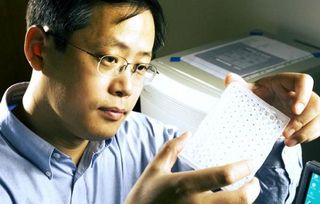DNA Chip like Printing Press for Synthetic Biology

If the printing press changed history by bringing the written word to the masses, just imagine what shake-ups a fast, reliable DNA printer could cause. A team of Duke University researchers hope to find out by playing Gutenberg to the synthetic biology set. The researchers have created a special chip that prints out DNA almost ten times faster, and with far smaller machinery and less human work, than conventional methods.
Creating and copying novel pieces of DNA quickly and inexpensively could have broad implications in the production and screening of new drugs, as well as replacing current technologies for genetic cloning, the researchers said.
"Using current technology, it takes between about 50 cents to a dollar to create each base pair of DNA; using the new chip reduces costs to less than half of one cent per base pair," said Jingdong Tian, assistant professor of biomedical engineering at Duke's Pratt School of Engineering.
The one inch by three inch chip itself has row upon row of tiny indentations, or wells. The biochemical equivalent of an inkjet printer shoots the desired DNA bases into each well. The bases assemble within the well and because it is a enzymatic reaction, harsh chemicals are not needed to release the DNA strand, as it done now, from the walls of the well.
As an example of how time-consuming and expensive current technology is, Tian cited the recent cloning of the entire genome of a single bacterium which took more than four years to complete, with a price tag of more than $40 million. The new chip system would have reduced that to a small fraction of the time and expense, Tian said.
[Read more: Unraveling the Human Genome: 6 Molecular Milestones ]
"The chip basically combines the three steps into one, which can be completed in less than two days, and without all the labor currently needed," Tian said. "Also, since the wells are so small, significantly smaller amounts of expensive chemicals are needed to run the reactions."
Sign up for the Live Science daily newsletter now
Get the world’s most fascinating discoveries delivered straight to your inbox.
The final step involves checking the product for any errors, which are usually missing or altered base pairs. This can be a time-consuming process, sometimes taking up to a week to complete.
"Using the chip-based system, we add an enzyme that can recognize when a base pair is not where it should be, cut the defect out, and reassemble the strand," Tian said. The researchers tested the chip on genes from E. coli and found that the error rate was much lower using the chip compared to traditional methods.
Because researchers can produce so many DNA strands so quickly, they can screen many versions with subtle differences to see which particular version produces the most of a desired protein, Tian said.
Follow InnovationNewsDaily on Twitter @News_Innovation, or on Facebook.
Most Popular




